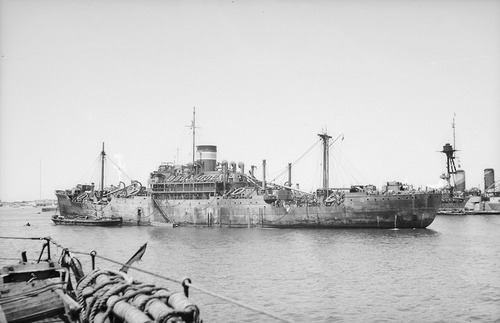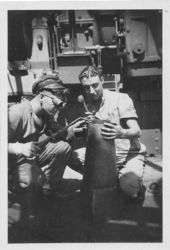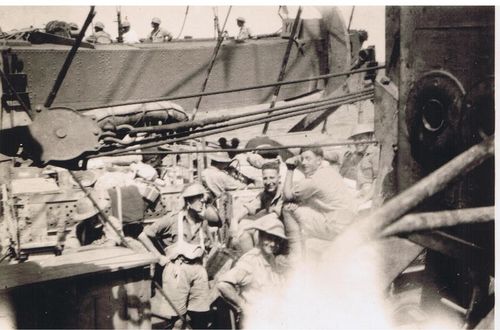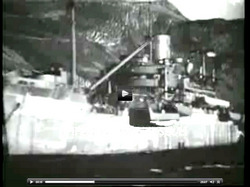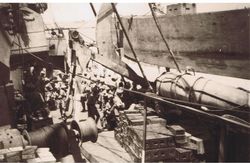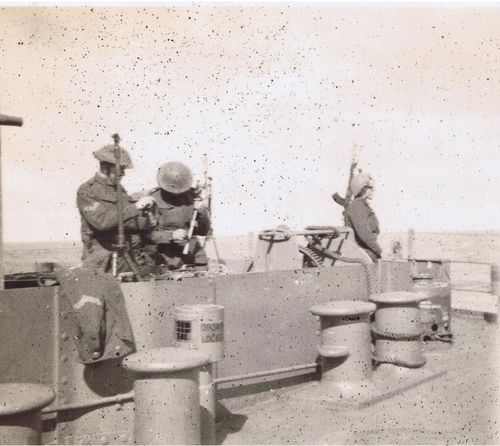A E WEBB ( BLacksmiths ACCOUNT)
FULL ACCOUNT with Photos
The account of Glenroy's Welder /Blacksmith ALBERT EDWIN WEBB PMX61705.
I went aboard HMS Glenroy at Liverpool 4th Oct 1940 where she was being converted to carry ALC( Assault landing craft) and army commandos. Two other ships owned by Blue funnel line the Glenearn and Glengyle where also being converted. Davits for the landing craft were being installed and extra lifting gear fitted to lift MLC's ( motorised landing craft), There was one on the forward well deck and one on the rear well deck.
As far as I can rmember there were 15 ALc and 1 SLc.
Accomodation had to be built to house the Commandos. Toilets showers mess decks and a very large cookhouse and bakery.When all jobs were completed we went for trials and then sailed for Grenock. Troops came on board and we sailed for Inverary.
We were then in a three ship unit( Combined Operations) and carried out exercises. Night assault landings at Roderick bay Isle of Arran. Troops had to be returned to their base ship to carry out unarmed combat training between landings.
We then set sail for the middleEast. The three Glenships, three destroyers and a cruiser, average speed 18 knots.
There were quite a few subs about and a flying boat patrol, not that we saw much of them, but we knew they were there. so did the enemy. We sailed right out into the Atlantic and then headed to Freetown (SA)We anchored out and from the shore came about three dozen canoe type of boats, each one manned by a naked black man, except for the leader who was wearing a top hat and white dress shirt front. On the boat was painted “Blackout Charlie”. We were supposed to throw coins in the water and that would cause a mad scramble as the natives dived for them. Orders were given that no fruit was to be bought off the boats laden with oranges etc.Some of the Commando’s thought that they were out of sight and lowered a rope down to one of the boats and the boatmen untied the rag containing money off the end of the rope and proceeded to fill up a basket. They had been noticed by a NCO and he picked up the basket and tipped the fruit into the sea and jumped on the basket All the lads involved were put on a charge.There was a large convoy in Freetown but it was too slow for us to join. It left that night and there was a fire in the Jungle. No doubt a signal that the convoy had sailed. The germans gave it a good mauling, We heard that the informer was caught but he had done a lot of damage, We sailed into Simmonds twon and were allowed leave in Cape Town. On to the Indian Ocean, the Red Sea , Suez. Leave was granted so off to Cairo for a couple of days.
Visited the Pyramids and a nightclub then back to Suez and the Suez canal. A few sunken ships to get slowly around.Port Said.,then on to Alexandria and the eastern MED.We were wondering why the three"Glen boats " were being sent there. The buzz was Rhodes was the target, but the Germans had control of the skies over it. We would have been sitting ducks.
We returned to Port said,down the canal to the bitter lakes, a stretch of water bewteen port Said and Suez. There we trianed troops for landings.( Aussies and NZers)The crafts landed up at night and ran ashore on the sides of the Bitter Lakes.I remember after one such exercise I was talking to a soldier who had been involved. It seemed that they were taking a field gun with them on the landing craft and the drill was for the craft to drop an anchor before reaching the beach, then when the craft grounded drop the ramp door and away with the men and equipment. The craft would then pull back off the beach on the anchor dropped on the way in. But on this exercise things had not gone to plan. The craft grounded okay and down went the ramp door, out went the gun and gun crew. The craft had not grounded on the beach it had landed on a sand bank. The gun and gun crew were in the water and not on the beach. It seems that the troops did not rate the landing craft crew very high, not that it was their fault. They may not have enjoyed the landings but they certainly enjoyed the .A place to sleep, relax and Naval food. was hammering Greece. t.Life on board continued with the troop training going on. We had a few nasty air raids at night.Then it was time for the three ships and the troops to move up to Alexandria. Things were not too bad in the desert but Jerry was hammering Greece. We were sent to load up with various stores and with HMS Cornwall ,an 8 inch Cruiser,we sailed back to the indian Ocean to the Maldives,
The idea was to make it a base and anchorage. The Coral reef had to have channels blown through for the landing craft to landthe entire stores etc,We had shore leave,it was a lovely place for peace and quiet, no shops no pubs just lovely beaches. On HMS Cornwall there were three lads who were in the same training class as me. I requested poermission to visit them and this was granted, They were pleased to see me and we had a good chat.Hms Cornwalls main job was patrolling the Indian Ocean to look out for raiders. I said,"You are too big for the eastern Med. Small fast ships have a job to survive."I was told to "P### O" and not talk stupid.Unfortuneatly HMS Cornwal was sunk within minutes of returning to patro after seeing Glenroy safey back to South Africa.l never heard how my mates fared.
The battle in the desert was still raging when we returned to Alexandriaand the gremans were going through Greece and Italy.There was a garrison of troops on Lemnos, The lads wereHerks and Berks Regiment.An attempt was to be made to get them safely off Lemnos and back to Alexandria. Three possibly four destroyers and an Anti aircraft Cruiser,our normal escort when we were at sea set sail. I cant recall the namesof the destroyers but the cruiser was sometimes HMS Coventry or HMs Calcutta. Im not sure which one on this occassion.We were joined by a Naval officer navigator who knew the aegean sea.I hoestly believ we would not have made it without his skill.
We arrived at Lemnos and our landing craft went into the harbour to start loading troops. That done we "upped "anchor and started the voyage back. we went around different Islands to put the enemy off, They really tried hard to find us and it wasnt until I met a lad who was on the Anti aircraft cruiser who told me about the number of planes they picked up on the RDF,it realised it.The soldiers had no idea how luckly they were and when i look at the map and see where we went during that trip. I think the Lord was looking down on us.On the way back I met a soldier outside my mess who came from Evesham( same as me)Like a lot of his mates he had been consuming some of their liquid stores. He was a pinter and decorator Chick Eames.
The three Glen Ships were required again.Hms Glengyle left the harbour followed by Glenroy then Glenearn.We were in a different channel to Glengyle . Of course all approaches were mined except the channels where the ships came and went. These were covered by a boom which was opened and shut when required. I do not know how we came to be going up the wrong channel but I had just come off the forecastle after securing the anchor when the ship scraped over some rocks' Bang" we were aground, we came to a halt and stuck fast.Glenearn had to go hard astern to avoid running into us.. Panic stations the oil fuel breathers shot black oil smothering the lads that happened to be closest. The Captain shouted from the bridge “Drop Anchor” I nearly let it go without taking the securing chain off.There we were in sight of Alex a sitting duck!Attempts were made to get Glenroy afloat. We removed the Anchor on the Starboard side and passed the cable to a tug, but no luck.Out came the tugs and we could not budge.Under the troop decks were tanks of aviation spirit for the landing craft, under that for ballast was stone chippings. . As ships Blacksmith I had to oxy-acetylene burn two holes about 18 inches square through the ships side.This was to enable a chute to be put in each. A barge was positioned underneath. The ships ballast was to be removed until she was light enough to come off the bottom. A gang of Egyptian labourers was brough aboard each armed witha wicker basket. They formed human chains and all nightpassed baskets of ballast from below to the troop deck chutes. All the while keeping up a sort of chant to keep the work going.The ballast consisted of small stone chips.When Glenroy was afloat it was into the harbour and into the floating dock to assess the damage.Some rivits were broken and it was not possible to realign the holes so it was decided to temporary electric weld and get Glenroy back into action.When we went on the rocks all our landing craft and crews had been taken off and loaded unto another ships . they had then joined with the other Glens. I was ordered to go over the side and patch up the holes I had cut to put the ballast through. This was not an easy job sitting on a plank held by ropes drilling three quarter of an inch holes two inches apart all around the holes to bolt the new plates on.
MAY 1941 ALex having ballast removed prior to going into Dry dock. Note she will be repainted at this time ( see the funnell )
The battle for Crete was in full swing , all sorts of Naval ships were being sunk and damaged.That story has been well documented so i'll just continue with Glenroys part.
We loaded on board 800 Queens regiment to be landed on Crete with their equipment.Strange really every other ship was trying to take troops off. (my late brother in law was one of the queens soldiers although not married to my sister at that time.)The soldiers stores were stacked all over the decks and down the holds. The lorries across the well deck,stacks of petrol in wooden tin lined boxeson the deck, Bren gun crews were up in each landing craft up in the davits. I burnt small holes as requested so the Bren gun stands could be wired up to secure the guns.On the troop decks the soldiers were loading bren magazines with bullets and a human chain passed them all over the ship to the Bren gun crews,This close range fire helped us all as once the planes were through the heavier gun fire,the pilot could see the tracer coming up at him and it was off putting. the queens were very brave lads land fighting was their job not being boxed up,not knowing half the time what was happening.Suddenly there was a stick of bombs alongside, the ship shuddered and I was sure that the engine has stopped because my heart nearly did. A blue flash went through the troop deck. I thought this is it! There and then I said a silent prayer to the Lord to spare us. It was such a lovely day and I was twenty one years old, some a lot older and some a lot younger. Then over the speaker came the request for stretcher bearers to report aft, I wondered if any of my mates were hurt, we had a station aft. Some wounded were bought into our station. One lad was holding his hands, which were smothered in blood, over his eyes saying “I can’t see” I felt sick.The Queens were sent to Burma and ended up as Chindits, My brother in law survived that.
The Queens note 3 brens per ALC ( 36 in all)
NOV 1941
Back in Alex the desert battles continued.It was decided a quicker method to unload ships at Tobruk was needed. the Australian Army supplied about 50 ex stevedores. we adjusted Glenroys davits to hoist wooden boats known as Jaffa barges inboard.We set sail for Tobruk, Hms Glenroy escorted by 3 destroyers,an anti aircraft cruiser and 2 RAF Fighters for cover.It was cuppa time approx 4pm,guns started firing and before we we had reached action stations there was a terrific BANG. A torpedo fired from an Italian torpedo bomber had hit HMS Glenroy.There were two planes ,both fired but fortunatley one missed. The planes had flown in just above the water. As lookouts were scanning the skies for enemy bombers the escorts were taken by surprise, The two fighters came hurtling down and our escort started firing on them -they quickly got out of range before the escorts realised they were ours.
Meanwhile Glenroy was taking in water and listing to port. The order "ABANDON SHIP" was given, The water in the engine room was levelling off, the watertight doors were closed and the bulkheads holding, How long for no one knew. all hands "BOAT STATIONS" the soldiers were in their alloted boats to be picked up by the escorts,
It was decided to try and beach Glenroy. all crew not required left the ship. I was required on the forecastle as we had to remove the anchor. I was involved.After a lot of hard work on Glenroy and on the cruiser our anchor cable was passed to the cruiser and we were under tow.This continued throughout the night.Next day i went with the Engineer commander, Chief engineer and first lieutenant to check how far up the holds the water was. It was at main deck level and it was decided that more officers and men could leave in the last remaining boat.The lord was with me as when i got into the baot no more could be taken. I ended up in HMAS NAPIER ( auusie destroyer) were me and my mates were fed and watered,Off to Alexandria were Napier was to refuel and return to sea. We just managed to pile off and were sent to live in tents outside Alex We were told we would have a few days rest nut HMS BARHAM a 15 inch battlewagon had been sunk so we were billetted in a hotel in Alexandria.
HMS Glenroy meantime had ended up on the seabed with water flowing over her main decks. A British Army unit experienced in salvage went to work with the Navy lads and kept her afloat using huge pumps etc. She was towed by naval tugs into Alex.I joined her with a crew to start repairs.Two large steel plates were carried by floating cranes and fixed to Glenroys damaged port side. The plates measured 20ft by 40ft when joined and divers worked underwater to fix them so that more water could be pumped out.This enabled the ship to go into a floating doack to have channel bars welded around and across the patch.I declined an offer from the officer in charge to don a diving suit and view first hand the repair work.

THE PATCH
We ( the glenroy) left the floating dock and anchored. The task of reinforcing the patch as it became know n and cleaning up the ship was started.We moved alongside the harbour wall and a large wooden box was built alongside and overlapping the patch, Once the operatiuon was started it had to continue without halting, Concrete was mixed and poured into the box until it was full. No let up it must be solid. Wooden shores were fixed at angles all around the box and wooden wedges held the shores firm.What used to be living quarters was now a stinking empty hold witha big wooden and concrete enclosure in one corner. The only way down a rope ladder. ( more about this later.)
Two 15inch Battle wagons Hms Valiant and Queen Elizabeth were decks awash having been sunk by Italian frogmen. As the Germans would be sending spotter planes over ,both ships, which were being made to leave Alex had to appear disabled. There had to be a way to make it appear as if they were burning. In this case Glenroy was surrounded by smoke cannisters on floates which could be electrically detonated. when a spy plane came over the smoke was let go according to the wind drifting it over the Glenroy, the Germans claimed both ships were burning, it certianly chocked us on Glenroy.
Next came the German push in the desert. All ships that could put to sea were to do so,including repair ships and submarine depot ships.
Hms Glenroy was to be towed into place as a blockship and HMS Janus, which wasnt seaworthy was to try and cover us.What crew that remained on Glenroy were to leave and make their own way to Suez with the exception of those needed to get the ship into position to be sunk should the battle for El Alamein be lost.
